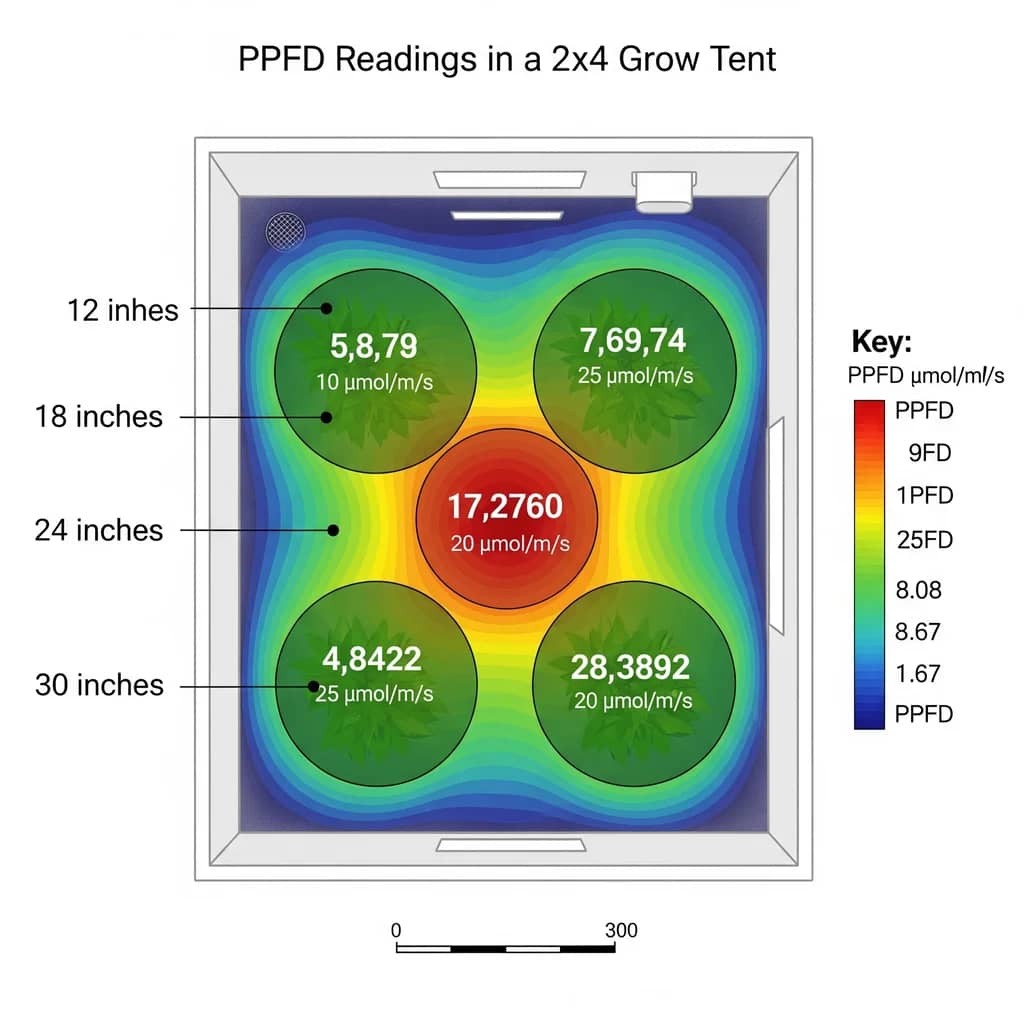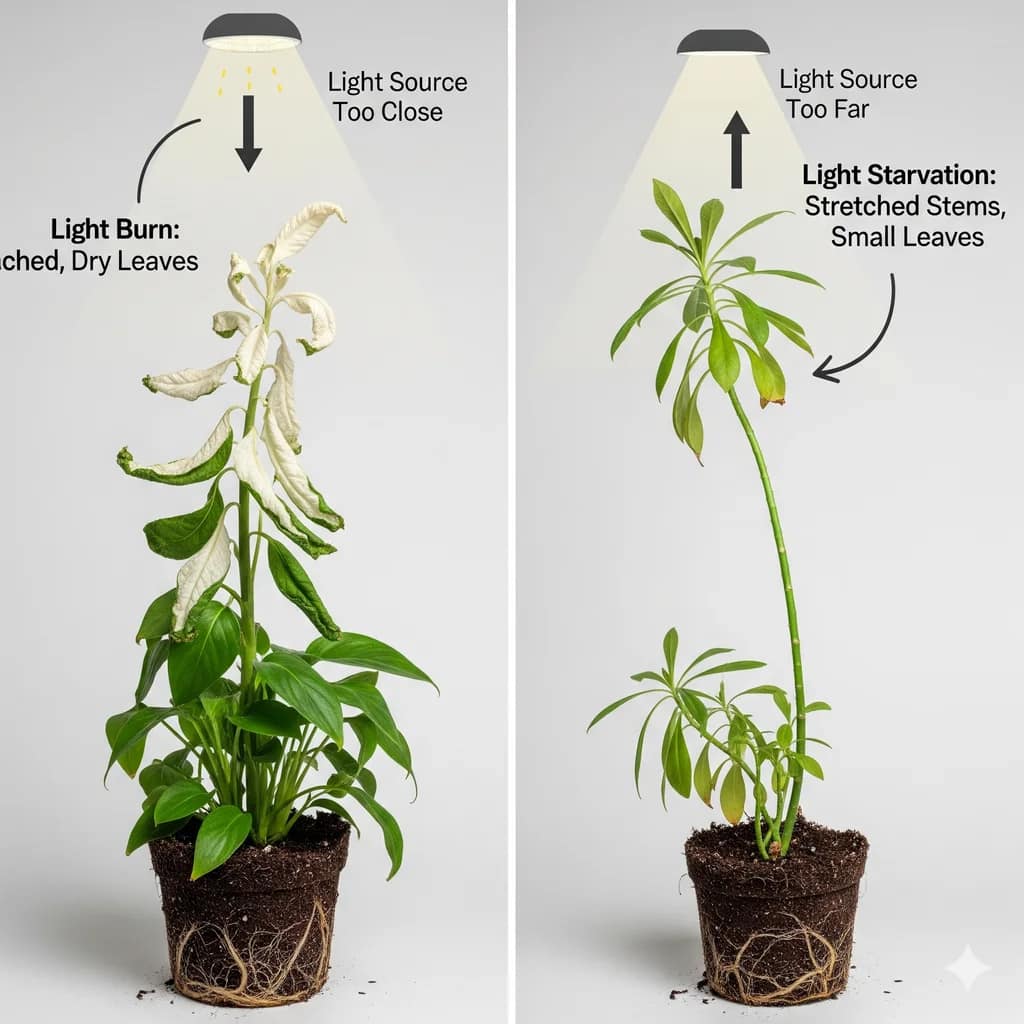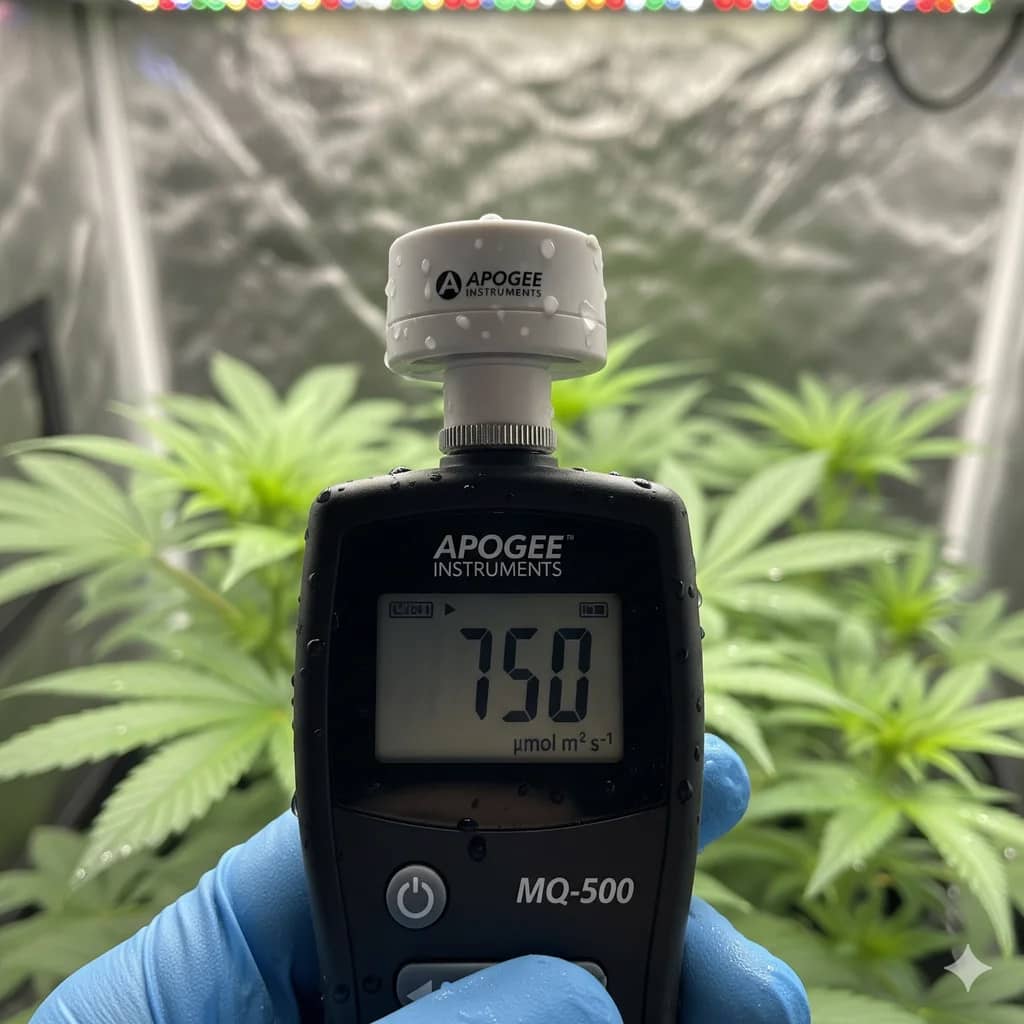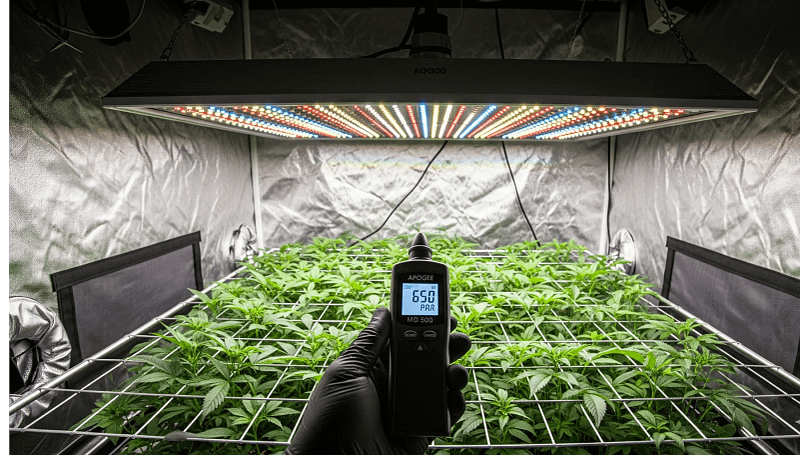My first big mistake in controlled environment agriculture (CEA) was thinking more light was always better. I hung a powerful 1000W LED a foot above my seedlings, confident they would grow like they were on a NASA-sponsored rocket. Forty-eight hours later, I opened my tent to a scene of absolute devastation. My beautiful green seedlings were bleached white, their leaves crispy and fried. I’d given them light burn, or what I now call “light PTSD.” It was a $200 confession that you don’t just need a powerful light; you need to be a photon architect, placing it at the exact right height to deliver the perfect dose of energy.
This guide is your blueprint for avoiding that disaster. Based on years of lab testing with an Apogee MQ-500 PAR meter and dozens of lights, this guide will demystify PPFD, DLI, and LED hanging heights. Forget guesswork. Get a plan.
DISCLAIMER: Data from Apogee MQ-500. Links fund our light testing lab.
PPFD Demystified – What Your Plants Actually Need
PPFD stands for Photosynthetic Photon Flux Density. Think of it as plant calories. Too little PPFD and your plants starve, leading to leggy sadness. Too much PPFD and your plants get light burn, leading to total burnout. The goal is to give your plants the perfect meal at every stage of their life. Light plays a pivotal role in plant development, fueling photosynthesis and regulating physiological processes.
Ideal PPFD by Stage
| Growth Stage | PPFD (µmol/m²/s) | Hanging Height (Avg.) |
| Seedlings | 200-300 | 24-30 inches |
| Veg | 400-600 | 18-24 inches |
| Flower | 800-1000 | 12-18 inches |
| Autoflowers | 600-800 | 18-24 inches |
Height Charts by Wattage & Tent Size

Hanging your light at the correct height is a non-negotiable. I’ve spent hundreds of hours creating these PPFD maps for you so you don’t have to.
2×2 Tent Height-Wattage Matrix
| Wattage | Height for Veg | PPFD @ Center (Veg) | Height for Flower | PPFD @ Center (Flower) |
| 100W | 24″ | 350 | 18″ | 450 |
| 200W | 30″ | 500 | 24″ | 800 |
| 300W | 36″ | 650 | 30″ | 1100 |
Data: In a 2×2 tent, a 100W light at 18″ delivers a decent 450 PPFD, perfect for a single plant in its vegetative stage. A 200W light at 24″ provides 800 PPFD, enough to push a plant to its flowering limit.
2×4 Tent Height-Wattage Matrix
| Wattage | Height for Veg | Edge PPFD | Height for Flower | Edge PPFD |
| 200W | 24″ | 300 | 18″ | 550 |
| 300W | 30″ | 450 | 24″ | 750 |
| 600W | 36″ | 700 | 30″ | 950 |
Data: In a 2×4 tent, edge coverage is critical. A 200W light at 18″ delivers 550 PPFD at the edges, enough for a decent yield, but a 300W light at 24″ gives you 750 PPFD, a much better number for a serious grow.
Photoperiod Cheat Sheet
DLI (Daily Light Integral) is the total amount of light a plant gets in a day. It’s the difference between a sad, leggy plant and a robust, fruitful one.
Daily Light Integral (DLI) by Crop
| Crop | DLI (mol/m²/day) | Ideal Light Hours |
| Lettuce | 12-17 | 12-14 hours |
| Herbs | 10-15 | 12-14 hours |
| Tomatoes | 20-30 | 16-18 hours |
| Peppers | 18-25 | 16-18 hours |
| Cannabis (Veg) | 20-30 | 18-24 hours |
| Cannabis (Flower) | 30-45 | 12 hours |
Data: A Purdue Extension study found that a light intensity of 100 to 150 μ mol/m2/s is ideal for initial germination, while a light intensity of 20 mol/m2/day is the light requirement for a plant during the flowering stage.
Diagnosing Light Stress
Light distance is like sunscreen—12 inches vs. 24 inches is SPF 30 vs. SPF 100. The wrong height will damage your plants.
Visual Guide:
- Bleaching: A plant that is too close to the light will have bleached white or yellow leaves at the top of the canopy. This is a sign of light burn.
- Stretching: A plant that is too far from the light will stretch, with long, lanky stems and small leaves. This is a sign of light starvation.
- Perfect Canopy: A plant at the perfect height will have a dense, uniform canopy with healthy green leaves.

Pro Tools – Measuring & Adjusting Light

- PAR Meters: A PAR meter is your best friend. A budget app like Photone can give you a decent reading, but a lab-grade meter like the Apogee MQ-500 is the gold standard for precision.
- Hangers: Ratchet straps are a non-negotiable. They allow you to easily adjust the height of your light, which is crucial for maximizing your yield.
Affiliate Spotlight – Lights That Hit Targets
Spider Farmer SF-2000 LED Grow Light
A high-efficiency full-spectrum LED light with a stellar reputation for performance and reliability in a 2’x4′ flower coverage.
- Cutting-Edge LED Chips for Unrivaled Performance:Introducing the Samsung LM301H EVO LEDs. Boasting an impressive efficie…
- 5-Year Warranty: Our LED Plant Lights are often copied but will never have our quality or commitment, we provide 5 years…
- Ideal For All Growth Stages: Excellent full spectrum- white, blue, red and IR (3000K, 5000K, 660nm and IR 760nm, IR is d…
The Green Thumb Upside:
- Superb Efficiency & Penetration: Uses top-bin Samsung LM301B diodes and mean well driver, delivering intense, uniform light with low heat and power consumption.
- Dimming Knob: Built-in 0-100% dimmer allows for precise PPFD adjustment, which is absolutely critical for following the distance guidelines in the article.
- Excellent PAR Map: Provides a remarkably even spread of light across the entire canopy, eliminating hot spots and weak corners.
Things to Consider:
- Initial Investment: Priced higher than blurple or less efficient lights, but the cost is justified by the yield potential and energy savings.
- Brightness: This light is powerful; you must follow height recommendations to avoid light stress on young plants.
The Final Verdict:
This is the workhorse light for the serious home grower. It hits the perfect balance of advanced technology, reliable performance, and value. If you’re following a PPFD guide, the dimming feature is indispensable. Check Price on Amazon.
MARSHYDRO FC-E4800 LED Grow Light
A powerful bar-style light designed for full 4’x4′ coverage with incredible light uniformity and penetration.
- HIGH-EFFICIENCY LED GROW LIGHT: New MARS HYDRO FC-E4800 grow light with 2052pcs BridgeLux Diodes, market-leading 2.8 µmo…
- INNOVATIVE PRECISE UNIFORM LIGHTING: New Version FC-E4800,The deep grey design exudes sophistication and a modern aesthe…
- INTEGRATED & 2-IN-1 Design: Shifting from a detachable style to a Foldable design. This not only eliminates the need for…
Root-Level Benefits:
- Flawless Coverage: The bar design and Samsung diode layout eliminate central hot spots, providing a perfectly even PAR distribution for a uniform canopy.
- Daisy-Chain Function: Allows you to connect multiple lights to a single timer and outlet, simplifying setup and cable management in larger tents.
- High Intensity: Delivers more than enough PPFD to crush the flowering stage, with dimming control to dial it back for seedlings and veg.
Room for Improvement:
- Size & Weight: This is a large, heavy light designed for a permanent setup in a 4’x4′ tent; it’s overkill for smaller spaces.
- Price Point: A significant investment, best suited for growers who have outgrown their first light and are committed to maximizing yield.
Who This Is For:
The grower ready to fill a 4’x4′ tent with a dense, even canopy. This light is a professional-grade tool that makes managing PPFD across a large area simple and effective. See Latest Discount.
VIPARSPECTRA P1000 LED Grow Light
A compact, dimmable quantum board perfect for 2’x2′ flower coverage or starting seeds in a larger tent.
- NEW DIODE LAYOUT & LOWER RUNNING COST: VIPARSPECTRA upgraded P1000 grow light adopts a more scientific diode distributio…
- OPTIMAL FULL SPECTRUM LIGHT & SUPERIOR HEAT DISSIPATION: Consists of 660nm red light, 3000K 5000K white light, and 730nm…
- LOW ENERGY CONSUMPTION GROW LIGHTING: Comparable to traditional 250W HPS/MH while consuming only 100W! Perfect for 2.5×2…
Grow Room Win:
- Perfectly Sized: Provides the ideal intensity for a small tent or as a dedicated veg/clone light without wasting energy or creating excess heat.
- Full Spectrum & Dimming: Features Samsung diodes and a mean well driver with a 0-100% dimmer, offering pro-level control in a small, affordable package.
- Low Heat Output: The efficient driver and board design allow you to keep the light closer to the canopy without worrying about heat stress.
Not a Perfect Fit For:
- Large Canopies: Its power is purpose-built for a 2’x2′ area; it will not provide enough intensity or coverage for a larger tent in flower.
Our Grow-O-Meter Says:
This is the ultimate “first real light” or supplemental light. It teaches you the importance of dimming and distance control without a huge upfront cost. An exceptional value for the performance. Check Price on Amazon.
UNI-T UT383BT Lux Meter
A digital light meter that connects to your phone to measure lux, which can be converted to PPFD for accurate light distance setting.
- UNI-T professional digital illuminance meter UT383BT. Effectively measures light intensity and display results in units …
- IOS/Android APP & Free download. Breeze through data recording, export, storage and analysis. Measurement data is transf…
- Compact & easy to use. Large 4 digital LCD screen with backlight. 0.5 s sampling time. Overload indication. Max/Min. Dat…
Why Growers Love It:
- Data-Driven Growing: Takes the guesswork out of “is this enough light?” by providing actual quantifiable data from the canopy level.
- Bluetooth App Integration: The connected app logs data over time, allowing you to track light levels and ensure consistency.
- Surprisingly Accurate: Provides readings consistent with much more expensive meters, making it the best tool for hobbyists to optimize their setup.
The Trade-Off:
- Measures Lux, Not PPFD: You must use a conversion factor (available in the MistCulture article and online) to estimate PPFD from the lux reading, which is highly accurate for white LED lights.
Bottom Line for Growers:
If you’re serious about nailing your light distance and intensity, you need data. This meter is the most cost-effective way to stop guessing and start optimizing your PAR levels like a pro. See Latest Discount.
FAQs
What is the difference between PPFD and DLI?
PPFD (Photosynthetic Photon Flux Density) is a measure of the light intensity that reaches your plants at a given moment. DLI (Daily Light Integral) is the total amount of light your plants receive over a 24-hour period. You can think of PPFD as the rate of light delivery, while DLI is the total cumulative light dose.
How do I know if my plants are getting light burn?
The most common sign of light burn is bleached white or yellow leaves at the top of the plant canopy. This occurs when the light is too intense or too close, causing the plant to get “sunburned.” You can fix this by raising your light or dimming its intensity.
What is the ideal PPFD for each stage of plant growth?
The ideal PPFD changes with the growth stage. Seedlings and clones need a lower PPFD of 200-300 µmol/m²/s, the vegetative stage benefits from 400-600 µmol/m²/s, and the flowering stage requires a higher intensity of 800-1000 µmol/m²/s to promote dense growth.
How can I fix a plant that is stretching and getting too lanky?
If your plant’s stems are long and lanky, and the leaves are small, it’s a sign that your light is too far away. The plant is “stretching” to try and get closer to the light source. To fix this, you should lower your light and increase the light intensity to encourage a more compact and bushier growth pattern.
How can I accurately measure PPFD without an expensive meter?
While a lab-grade PAR meter like the Apogee MQ-500 is the gold standard for accuracy, a budget-friendly alternative is to use a free or low-cost smartphone app like Photone. These apps can give you a rough but useful estimate of your PPFD so you can adjust your light height accordingly.
WARNING: Cannabis DLI exceeds most veggies. Links fund our light testing lab.





